Experimental Analysis of Drying Conditions’ Effect on the Drying Kinetics and Moisture Desorption Isotherms at Several Temperatures on Food Materials: Corn Case Study
Abstract
1. Introduction
| Product | Best Fitted Model | Temperature (°C) | Publication |
|---|---|---|---|
| Apple, Apricots | Halsey | 30, 45, 60 | [41] |
| Banana | Modified Fraundlich | 10, 15, 20, 30, 40 | [42] |
| Beef | BET | 25, 40 | [43] |
| Berries | GAB | 4, 13, 27 | [44] |
| Celery | Peleg | 25, 40, 50 | [45] |
| Cheese | GAB | 4, 8, 12 | [46] |
| Chicken meat | BET | 25 | [47] |
| Cocoa beans | GAB | 25, 35, 45, 55 | [48] |
| Crystalline lactose powder | Timmerann-GAB, GAB | 12–40 | [49] |
| Cured beef and pork | GAB, Peleg | 10–50 | [50] |
| Currants, Prunes, Figs | GAB | 15, 30, 45, 60 | [51] |
| Eggs | GAB | 60–80 | [52] |
| Gelatin gel | Ferro-Fontan, Modified GAB | 3.5–20 | [24] |
| Grapes, Potato | GAB, Halsey | 30, 45, 60 | [53,54] |
| Green pepper | Halsey | 30, 45, 60 | [55] |
| Hazelnuts | Freundlich | 50, 60, 70, 80, 90 | [56] |
| Lemon | GAB | 20, 30, 40, 50 | [57] |
| Macadamia nuts | GAB | 25, 35, 45 | [58] |
| Mango | BET | 40, 50, 60 | [59] |
| Milks | GAB | 15, 25, 35, 45 | [60] |
| Mushroom | GAB, BET | 40, 50, 60 | [61] |
| Onion | Modified Halsey | 30, 40, 50 | [62] |
| Pineapple | BET | 40, 50, 60 | [63] |
| Raisin | GAB | 15, 30, 45, 60 | [64] |
| Rice | Chung Pfost | 10, 20, 30, 40, 50 | [65] |
| Sorghum | Modified Chung-Pfost | 40, 50 | [66] |
| Starch (maize) | GAB | 45 | [67] |
| Starch, Potato | GAB | 30–60 | [68] |
| Tomato | GAB | 25, 40, 50 | [69] |
- (i)
- To provide information about the temperature distribution and moisture content drying of thin layers and a packed bed of corn under different drying conditions;
- (ii)
- To investigate the variation in corn density and the specific volume of corn kernels during the drying operation;
- (iii)
- To analyze the desorption isotherms of corn kernels in a wide range of relative humidities (10–90%) at three temperatures levels: 50, 60 and 70 °C;
- (iv)
- To estimate the thermodynamic properties of corn kernels depending on the moisture content;
- (v)
- To evaluate the pertinence of the enthalpy–entropy theory;
- (vi)
- To identify the desorption mechanism if enthalpy or entropy is controlled.
2. Materials and Methods
2.1. Experimental Procedure
2.1.1. Determination of the Apparent Density
2.1.2. Experimental Apparatus of Drying Kinetics
2.2. Pre-Treatment of Corn
2.3. Kinetic Drying of Thin Layer of Corn
2.4. Uncertainty Analysis
2.5. Reproducibility
2.6. Desorption Isotherm Method
2.6.1. Fitting of Various Models to Desorption Isotherm Curves
2.6.2. Determination of the Net Isosteric Heat of Desorption
3. Results and Discussion
3.1. The Apparent Density
3.2. The Specific Volume
3.3. Drying Kinetic
3.3.1. Effect of the Air Temperature
3.3.2. Effect of the Air Velocity
3.3.3. Effect of the Relative Humidity of the Air
3.3.4. Comparison between the Convective Drying of a Packed Bed and a Thin Layer
3.4. Desorption Isotherm
3.4.1. Fitting of Various Models to Desorption Isotherm Curves
3.4.2. The Determination of the Net Isosteric Heat of Sorption
3.4.3. Sorption Entropy
3.4.4. The Isokinetic Theory
4. Conclusions
Author Contributions
Funding
Data Availability Statement
Acknowledgments
Conflicts of Interest
Nomenclature
| A, B, C, c, D, k, Xm | Models’ parameters | - |
| aw | Water activity | - |
| d.b | Dry base | - |
| df | Number of degrees of freedom | |
| G | Hydrostatic thrust | kg |
| H | Height of the bed of corn | M |
| h0 | Net isosteric heat of sorption | KJ/mol |
| Meq | Equilibrium mass | kg |
| Mf | Mass of the sample immersed in the fluid | kg |
| MH2O | Mass of water | kg |
| ml | Solid mass | kg |
| ml0 | Initial liquid mass | kg |
| ms | Solid mass | kg |
| N | Number of experimental points | - |
| P | Pressure | Pa |
| R | Ideal gas constant | KJ/mol·K |
| RH | Relative humidity of the air | % |
| R2 | Correlation coefficient | - |
| T | Temperature | K |
| Tβ | Isokinetic temperature | K |
| Th | Harmonic mean temperature | K |
| V | Volume | m3 |
| V | Fluid velocity | m/s |
| Partial specific volume | m3 | |
| Vl0 | Initial volume of liquid | m3 |
| Vs | Solid volume | m3 |
| W | Moisture content | kg/kg (d.b) |
| W0 | Initial moisture content | kg/kg (d.b) |
| Wt | Moisture content at time t | kg/kg (d.b) |
| Wi,cal | Calculated equilibrium moisture content | kg/kg (d.b) |
| Wi,eq | Experimental equilibrium moisture content | kg/kg (d.b) |
| Greek symbols: | ||
| Solid density | kg/m3 | |
| a | Air density | kg/m3 |
| f | Solid density | kg/m3 |
| Average initial density | kg/m3 | |
| Average liquid density | kg/m3 | |
| Average initial density | kg/m3 | |
| Average solid density | kg/m3 | |
| Initial porosity | - | |
| Differential entropy | J/mol·K | |
| Standard error | - | |
| Free energy | J/mol | |
| Total heat of sorption | KJ/mol | |
| Net isosteric heat of sorption | KJ/mol | |
| Enthalpy of vaporization | KJ/mol | |
| Differential entropy | J/mol·K |
Appendix A
References
- Torero Cullen, M.M. L’avenir de L’alimentation et de L’agriculture—Facteurs et Déclencheurs de Transformation; FAOSTAT: Rome, Italy, 2022. [Google Scholar]
- Lelaalhe, M.; Tidjani, O. Céréales d’été dans le Sahara Algérien; Situation Actuelle et Perspectives. Ph.D. Thesis, Universite Kasdi Merbah–Ouargla, Ouargla, Algeria, 2021. [Google Scholar]
- Abass, A.B.; Ndunguru, G.; Mamiro, P.; Alenkhe, B.; Mlingi, N.; Bekunda, M. Post-harvest food losses in a maize-based farming system of semi-arid savannah area of Tanzania. J. Stored Prod. Res. 2014, 57, 49–57. [Google Scholar] [CrossRef]
- Kumar, D.; Kalita, P. Reducing Postharvest Losses during Storage of Grain Crops to Strengthen Food Security in Developing Countries. Foods 2017, 6, 8. [Google Scholar] [CrossRef] [PubMed]
- Kraiem, A.; Madiouli, J.; Sghaier, J.; Shigidi, I. Significance of Bed Shrinkage on Heat and Mass Transfer during the Transport Phenomenon of Humid Air. Arab. J. Sci. Eng. 2021, 46, 6085–6099. [Google Scholar] [CrossRef]
- Motahayyer, M.; Arabhosseini, A.; Samimi-Akhijahani, H. Numerical analysis of thermal performance of a solar dryer and validated with experimental and thermo-graphical data. Sol. Energy 2019, 193, 692–705. [Google Scholar] [CrossRef]
- Tuncer, A.D.; Khanlari, A.; Sözen, A.; Gürbüz, E.Y.; Şirin, C.; Gungor, A. Energy-exergy and enviro-economic survey of solar air heaters with various air channel modifications. Renew. Energy 2020, 160, 67–85. [Google Scholar] [CrossRef]
- Çelik, E.; Parlak, N.; Çay, Y. Experimental and numerical study on drying behavior of CORN grain. Heat Mass Transf. 2021, 57, 321–332. [Google Scholar] [CrossRef]
- Bryś, A.; Kaleta, A.; Górnicki, K.; Głowacki, S.; Tulej, W.; Bryś, J.; Wichowski, P. Some Aspects of the Modelling of Thin-Layer Drying of Sawdust. Energies 2021, 14, 726. [Google Scholar] [CrossRef]
- Guclu, G.; Keser, D.; Kelebek, H.; Keskin, M.; Sekerli, Y.E.; Soysal, Y.; Selli, S. Impact of production and drying methods on the volatile and phenolic characteristics of fresh and powdered sweet red peppers. Food Chem. 2021, 338, 128129. [Google Scholar] [CrossRef]
- Turan, A.; Karaosmanoğlu, H. Effect of drying methods on long term storage of hazelnut. Food Sci. Technol. 2019, 39, 406–412. [Google Scholar] [CrossRef]
- Van Pham, K.; Duc, L.A.; Hay, N. Mathematical Model of Thin Layer Drying of Ganoderma Lucidum by Radio Frequency Assisted Heat Pump Drying. Front. Heat Mass Transf. 2022, 18, 44. [Google Scholar] [CrossRef]
- Qiu, L.; Zhang, M.; Tang, J.; Adhikari, B.; Cao, P. Innovative technologies for producing and preserving intermediate moisture foods: A review. Food Res. Int. 2019, 116, 90–102. [Google Scholar] [CrossRef] [PubMed]
- Palabinskis, J.; Aboltins, A. Comparison of wheat drying process dynamics at different ventilation speeds. Eng. Rural Dev. 2021, 20, 520–527. [Google Scholar] [CrossRef]
- Ramaj, I.; Schock, S.; Müller, J. Drying Kinetics of Wheat (Triticum aestivum L., cv. ‘Pionier’) during Thin-Layer Drying at Low Temperatures. Appl. Sci. 2021, 11, 9557. [Google Scholar] [CrossRef]
- Maisnam, D.; Rasane, P.; Dey, A.; Kaur, S.; Sarma, C. Recent advances in conventional drying of foods: A review Recent advances in conventional drying of foods. J. Food Technol. Pres. 2017, 1, 25–34. [Google Scholar]
- Iuga, M.; Mironeasa, S. A review of the hydrothermal treatments impact on starch based systems properties. Crit. Rev. Food Sci. Nutr. 2019, 60, 3890–3915. [Google Scholar] [CrossRef] [PubMed]
- Sun, L.-X.; Liu, S.-X.; Wang, J.-X.; Wu, C.-L.; Li, Y.; Zhang, C.-Q. The effects of grain texture and phenotypic traits on the thin-layer drying rate in maize (Zea mays L.) inbred lines. J. Integr. Agric. 2016, 15, 317–325. [Google Scholar] [CrossRef]
- Jiang, M.; Wu, P.; Liu, H.; Li, L.; Jia, C.; Chen, S.; Zhang, S.; Wang, L. Interaction of swing temperature and alternating airflow with vibration on drying uniformity in deep-bed wheat drying. Dry. Technol. 2020, 38, 1749–1759. [Google Scholar] [CrossRef]
- Abasi, S.; Minaei, S. Effect of Drying Temperature on Mechanical Properties of Dried Corn. Dry. Technol. 2014, 32, 774–780. [Google Scholar] [CrossRef]
- Tohidi, M.; Sadeghi, M.; Torki-Harchegani, M. Energy and quality aspects for fixed deep bed drying of paddy. Renew. Sustain. Energy Rev. 2017, 70, 519–528. [Google Scholar] [CrossRef]
- Liu, Z.; Wu, Z.; Wang, X.; Song, J.; Wu, W. Numerical Simulation and Experimental Study of Deep Bed Corn Drying Based on Water Potential. Math. Probl. Eng. 2015, 2015, 539846. [Google Scholar] [CrossRef]
- Veras, O.; Béttega, R.; Freire, F.B.; Barrozo, M.; Freire, J.T. Drying kinetics, structural characteristics and vitamin C retention of dedo-de-moça pepper (Capsicum baccatum) during convective and freeze drying. Braz. J. Chem. Eng. 2012, 29, 741–750. [Google Scholar] [CrossRef]
- Moussaoui, H.; Bahammou, Y.; Idlimam, A.; Lamharrar, A.; Abdenouri, N. Investigation of hygroscopic equilibrium and modeling sorption isotherms of the argan products: A comparative study of leaves, pulps, and fruits. Food Bioprod. Process. 2019, 114, 12–22. [Google Scholar] [CrossRef]
- Mahato, D.; Devi, S.; Pandhi, S.; Sharma, B.; Maurya, K.; Mishra, S.; Dhawan, K.; Selvakumar, R.; Kamle, M.; Mishra, A.; et al. Occurrence, Impact on Agriculture, Human Health, and Management Strategies of Zearalenone in Food and Feed: A Review. Toxins 2021, 13, 92. [Google Scholar] [CrossRef] [PubMed]
- Webb, D.J. Fibre Bragg grating sensors in polymer optical fibres. Meas. Sci. Technol. 2015, 26, 092004. [Google Scholar] [CrossRef]
- Bala, B.; Woods, J. Physical and Thermal Properties of Malt. Dry. Technol. 1991, 9, 1091–1104. [Google Scholar] [CrossRef]
- Park, S.Y.; Oh, Y.J.; Lho, Y.; Jeong, J.H.; Liu, K.-H.; Song, J.; Kim, S.-H.; Ha, E.; Seo, Y.H. Design, synthesis, and biological evaluation of a series of resorcinol-based N-benzyl benzamide derivatives as potent Hsp90 inhibitors. Eur. J. Med. Chem. 2018, 143, 390–401. [Google Scholar] [CrossRef]
- Singh, P.; Talukdar, P. Determination of Desorption Isotherms of Potato Using Gravimetric Method and Fast Isotherm Method. Heat Transf. Eng. 2020, 41, 513–521. [Google Scholar] [CrossRef]
- Hassini, L.; Bettaieb, E.; Desmorieux, H.; Torres, S.S.; Touil, A. Desorption isotherms and thermodynamic properties of prickly pear seeds. Ind. Crop. Prod. 2015, 67, 457–465. [Google Scholar] [CrossRef]
- Ben Abdelhamid, M.; Mihoubi, D.; Sghaier, J.; Bellagi, A. Water Sorption Isotherms and Thermodynamic Characteristics of Hardened Cement Paste and Mortar. Transp. Porous Media 2016, 113, 283–301. [Google Scholar] [CrossRef]
- Manzocco, L.; Plazzotta, S.; Powell, J.; de Vries, A.; Rousseau, D.; Calligaris, S. Structural characterisation and sorption capability of whey protein aerogels obtained by freeze-drying or supercritical drying. Food Hydrocoll. 2021, 122, 107117. [Google Scholar] [CrossRef]
- Lestari, R.; Pradani, T.; Digdowiseiso, K. The Effects of Price Perceptions, Food Quality, and Menu Variations on Ordering Decisions and Their Impact on Customer Loyalty in Online Culinary Products. Bp. Int. Res. Crit. Inst.-J. 2022, 5, 1518–1527. [Google Scholar]
- Norström, M.; Kristoffersen, A.B.; Görlach, F.S.; Nygard, K.; Hopp, P. An Adjusted Likelihood Ratio Approach Analysing Distribution of Food Products to Assist the Investigation of Foodborne Outbreaks. PLoS ONE 2015, 10, e0134344. [Google Scholar] [CrossRef]
- Sormoli, M.E.; Langrish, T.A. Moisture sorption isotherms and net isosteric heat of sorption for spray-dried pure orange juice powder. LWT Food Sci. Technol. 2015, 62, 875–882. [Google Scholar] [CrossRef]
- Labuza, T.P.; Altunakar, B. Water activity prediction and moisture sorption isotherms. Water Act. Foods Fundam. Appl. 2020, 2, 161–205. [Google Scholar]
- Onwude, D.I.; Hashim, N.; Janius, R.B.; Nawi, N.M.; Abdan, K. Modeling the Thin-Layer Drying of Fruits and Vegetables: A Review. Compr. Rev. Food Sci. Food Saf. 2016, 15, 599–618. [Google Scholar] [CrossRef] [PubMed]
- Nienke, T.; Kwade, A.; Eggerath, D. Influence of Moisture, Temperature and Bleaching on the Mechanical Properties of Coated Fiber-Based Substrates. Coatings 2022, 12, 1287. [Google Scholar] [CrossRef]
- Marques, R.C.D.; de Oliveira, R.; Coutinho, G.S.M.; Ribeiro, A.E.C.; Teixeira, C.S.; Júnior, M.S.S.; Caliari, M. Modeling sorption properties of maize by-products obtained using the Dynamic Dewpoint Isotherm (DDI) method. Food Biosci. 2020, 38, 100738. [Google Scholar] [CrossRef]
- César, L.-V.E.; Lilia, C.-M.A.; Octavio, G.-V.; Isaac, P.F.; Rogelio, B.O. Thermal performance of a passive, mixed-type solar dryer for tomato slices (Solanum lycopersicum). Renew. Energy 2020, 147, 845–855. [Google Scholar] [CrossRef]
- Peleg, M. Models of Sigmoid Equilibrium Moisture Sorption Isotherms With and Without the Monolayer Hypothesis. Food Eng. Rev. 2020, 12, 1–13. [Google Scholar] [CrossRef]
- Susilo, B.; Maharani, D.M.; Hawa, L.C.; Fitri, D.N.K. Study of sorption isotherm and isosteric heat of Kepok Banana (Musa paradisiaca F.) slice. IOP Conf. Ser. Earth Environ. Sci. 2019, 230, 012017. [Google Scholar] [CrossRef]
- Amadou, I.; Diadie, H.O.; Gbadamosi, O.S.; Akanbi, C.T. Characterization and sorption isotherm of dehydrated beef made in Nigeria. Cogent Food Agric. 2019, 5, 1710440. [Google Scholar] [CrossRef]
- Engin, D. Effect of drying temperature on color and desorption characteristics of oyster mushroom. Food Sci. Technol. 2020, 40, 187–193. [Google Scholar] [CrossRef]
- Staniszewska, I.; Dzadz, L.; Nowak, K.W.; Zielinska, M. Evaluation of storage stability of dried powdered coriander, parsley and celery leaves based on the moisture sorption isotherms and glass transition temperature. LWT 2021, 146, 111440. [Google Scholar] [CrossRef]
- Martinez-Monteagudo, S.I.; Salais-Fierro, F. Moisture sorption isotherms and thermodynamic properties of Mexican Mennonite-style cheese. J. Food Sci. Technol. 2014, 51, 2393–2403. [Google Scholar] [CrossRef] [PubMed][Green Version]
- Cagabhion, A.; Emnace, I. Moisture Sorption Characteristics and Isosteric Heat of Sorption of Vacuum Fried Chicken (Gallus gallus domesticus L.) “Isaw”. Philipp. J. Sci. 2020, 150, 43–52. [Google Scholar] [CrossRef]
- Baptestini, F.M.; Corrêa, P.C.; Ramos, A.M.; Junqueira, M.D.S.; Zaidan, I.R. GAB model and the thermodynamic properties of moisture sorption in soursop fruit powder. Rev. Cienc. Agron. 2020, 51, 1–9. [Google Scholar] [CrossRef]
- Yan, H.; Yu, Z.; Liu, L. Lactose crystallization and Maillard reaction in simulated milk powder based on the change in water activity. J. Food Sci. 2022, 87, 4956–4966. [Google Scholar] [CrossRef] [PubMed]
- Barretto, T.L.; Polachini, T.; Barretto, A.C.D.S.; Telis-Romero, J. Water sorption isotherms of cooked hams as affected by temperature and chemical composition. Food Sci. Technol. 2019, 39, 677–683. [Google Scholar] [CrossRef]
- Chauhan, O.P. (Ed.) Advances in Food Chemistry: Food Components, Processing and Preservation; Springer: Singapore, 2022. [Google Scholar]
- Hurley, B.R.A.; Ouzts, A.; Fischer, J.; Gomes, T. Effects of Private and Public Label Packaging on Consumer Purchase Patterns. Packag. Technol. Sci. 2013, 29, 399–412. [Google Scholar] [CrossRef]
- Nguyen, G.T.; Sopade, P.A. Modeling Starch Digestograms: Computational Characteristics of Kinetic Models for in vitro Starch Digestion in Food Research. Compr. Rev. Food Sci. Food Saf. 2018, 17, 1422–1445. [Google Scholar] [CrossRef] [PubMed]
- Majd, K.M.; Karparvarfard, S.H.; Farahnaky, A.; Jafarpour, K. Thermodynamic of Water Sorption of Grape Seed: Temperature Effect of Sorption Isotherms and Thermodynamic Characteristics. Food Biophys. 2013, 8, 1–11. [Google Scholar] [CrossRef]
- Aguirre-Loredo, R.Y.; Rodriguez-Hernandez, A.I.; Velazquez, G. Modelling the effect of temperature on the water sorption isotherms of chitosan films. Food Sci. Technol. 2017, 37, 112–118. [Google Scholar] [CrossRef]
- Nassar, M.Y.; Abdelrahman, E.A.; Aly, A.A.; Mohamed, T.Y. A facile synthesis of mordenite zeolite nanostructures for efficient bleaching of crude soybean oil and removal of methylene blue dye from aqueous media. J. Mol. Liq. 2017, 248, 302–313. [Google Scholar] [CrossRef]
- Bejar, A.K.; Mihoubi, N.B.; Kechaou, N. Moisture sorption isotherms—Experimental and mathematical investigations of orange (Citrus sinensis) peel and leaves. Food Chem. 2012, 132, 1728–1735. [Google Scholar] [CrossRef]
- Maestri, D.; Cittadini, M.C.; Bodoira, R.; Martínez, M. Tree Nut Oils: Chemical Profiles, Extraction, Stability, and Quality Concerns. Eur. J. Lipid Sci. Technol. 2020, 122, 1900450. [Google Scholar] [CrossRef]
- Koua, B.K.; Koffi, P.M.E.; Gbaha, P.; Toure, S. Thermodynamic analysis of sorption isotherms of cassava (Manihot esculenta). J. Food Sci. Technol. 2014, 51, 1711–1723. [Google Scholar] [CrossRef] [PubMed]
- Nascimento, A.; Cavalcanti-Mata, M.E.R.M.; Duarte, M.E.M.; Pasquali, M.; Lisboa, H.M. Construction of a design space for goat milk powder production using moisture sorption isotherms. J. Food Process Eng. 2019, 42, e13228. [Google Scholar] [CrossRef]
- Tolera, K.D.; Abera, S. Nutritional quality of Oyster Mushroom (Pleurotus Ostreatus) as affected by osmotic pretreatments and drying methods. Food Sci. Nutr. 2017, 5, 989–996. [Google Scholar] [CrossRef] [PubMed]
- Sasongko, S.B.; Hadiyanto, H.; Djaeni, M.; Perdanianti, A.M.; Utari, F.D. Effects of drying temperature and relative humidity on the quality of dried onion slice. Heliyon 2020, 6, e04338. [Google Scholar] [CrossRef]
- Udomkun, P.; Argyropoulos, D.; Nagle, M.; Mahayothee, B.; Müller, J. Sorption behaviour of papayas as affected by compositional and structural alterations from osmotic pretreatment and drying. J. Food Eng. 2015, 157, 14–23. [Google Scholar] [CrossRef]
- Koc, B.; Isleroglu, H.; Turker, I. Sorption behavior and storage stability of microencapsulated transglutaminase by ultrasonic spray–freeze–drying. Dry. Technol. 2020, 40, 337–351. [Google Scholar] [CrossRef]
- Zeymer, J.S.; Corrêa, P.C.; Oliveira, G.H.H.; Baptestini, F.M.; Campos, R.C. Mathematical modeling and hysteresis of sorption isotherms for paddy rice grains. Eng. Agric. 2019, 39, 524–532. [Google Scholar] [CrossRef]
- Gichau, A.W.; Okoth, J.K.; Makokha, A. Moisture sorption isotherm and shelf life prediction of complementary food based on amaranth–sorghum grains. J. Food Sci. Technol. 2019, 57, 962–970. [Google Scholar] [CrossRef]
- Groundnut, B.; Flour, N.; Adeoye, B.K.; Oladejo, C.J.; Adeniran, A.D.; Opawuyi, H.T. Sorption Isotherm of Corn Chips Made from Blends of Corn Flour and Bambara Groundnut Nut Flour. Am. J. Chem. Eng. 2021, 8, 70. [Google Scholar] [CrossRef]
- Panyathitipong, W.; Tempiam, S.; Suttha, W.; Chomshome, N.; Masavang, S. Effect of Storage Conditions on Qualities and Water Sorption Isotherm of Khanom La. Trends Sci. 2022, 19, 3466. [Google Scholar] [CrossRef]
- Adebowale, A.A.; Akinniyi, G.; Shittu, T.A.; Adegoke, A.F.; Omohimi, C.I.; Sobukola, O.P.; Onabanjo, O.O.; Adegunwa, M.O.; Kajihausa, O.E.; Dairo, O.U.; et al. Adsorption Isotherms and Thermodynamic Properties of Dried Tomato Slices. Adv. Nutr. Food Sci. 2022, 7, 249–262. [Google Scholar]
- Soodmand-Moghaddam, S.; Sharifi, M.; Zareiforoush, H.; Mobli, H. Mathematical modelling of lemon verbena leaves drying in a continuous flow dryer equipped with a solar pre-heating system. Qual. Assur. Saf. Crop. Foods 2020, 12, 57–66. [Google Scholar] [CrossRef]
- Jalil, E.; Molaeimanesh, G.R. Effects of turbulator shape, inclined magnetic field, and mixed convection nanofluid flow on thermal performance of micro-scale inclined forward-facing step. J. Cent. South Univ. 2021, 28, 3310–3326. [Google Scholar] [CrossRef]
- Muruganantham, P.; Kamalakannan, K.; Sathyamurthy, R.; Sundaram, K.M. Performance analysis of a tubular solar dryer for drying Mexican mint (Plectranthus amboinicus)—An experimental approach. Energy Rep. 2021, 7, 7–12. [Google Scholar] [CrossRef]
- Sheikholeslami, M.; Ganji, D. Heat transfer improvement in a double pipe heat exchanger by means of perforated turbulators. Energy Convers. Manag. 2016, 127, 112–123. [Google Scholar] [CrossRef]
- Lucia, U.; Simonetti, M.; Chiesa, G.; Grisolia, G. Ground-source pump system for heating and cooling: Review and thermodynamic approach. Renew. Sustain. Energy Rev. 2017, 70, 867–874. [Google Scholar] [CrossRef]
- Mejouyo, P.W.H.; Tiaya, E.M.; Tagne, N.R.S.; Tiwa, S.T.; Njeugna, E. Experimental study of water-sorption and desorption of several varieties of oil palm mesocarp fibers. Results Mater. 2022, 14, 100284. [Google Scholar] [CrossRef]
- Falade, K.O.; Ayetigbo, O.E. Influence of physical and chemical modifications on granule size frequency distribution, fourier transform infrared (FTIR) spectra and adsorption isotherms of starch from four yam (Dioscorea spp.) cultivars. J. Food Sci. Technol. 2022, 59, 1865–1877. [Google Scholar] [CrossRef]
- Montes, D.; Orozco, W.; Taborda, E.A.; Franco, C.A.; Cortés, F.B. Development of Nanofluids for Perdurability in Viscosity Reduction of Extra-Heavy Oils. Energies 2019, 12, 1068. [Google Scholar] [CrossRef]
- Martynenko, A. True, Particle, and Bulk Density of Shrinkable Biomaterials: Evaluation from Drying Experiments. Dry. Technol. 2014, 32, 1319–1325. [Google Scholar] [CrossRef]
- Silva, V.; Figueiredo, A.; Costa, J.; Guiné, R. Experimental and mathematical study of the discontinuous drying kinetics of pears. J. Food Eng. 2014, 134, 30–36. [Google Scholar] [CrossRef]
- Özahi, E.; Demir, H. Drying performance analysis of a batch type fluidized bed drying process for corn and unshelled pistachio nut regarding to energetic and exergetic efficiencies. Measurement 2015, 60, 85–96. [Google Scholar] [CrossRef]
- Asemu, A.M.; Habtu, N.G.; Delele, M.A.; Subramanyam, B.; Alavi, S. Drying characteristics of maize grain in solar bubble dryer. J. Food Process Eng. 2020, 43, e13312. [Google Scholar] [CrossRef]
- Ertekin, C.; Firat, M.Z. A comprehensive review of thin-layer drying models used in agricultural products. Crit. Rev. Food Sci. Nutr. 2017, 57, 701–717. [Google Scholar] [CrossRef]
- Katsoufi, S.; Lazou, A.E.; Giannakourou, M.C.; Krokida, M.K. Air drying kinetics and quality characteristics of osmodehydrated-candied pumpkins using alternative sweeteners. Dry. Technol. 2020, 39, 2194–2205. [Google Scholar] [CrossRef]
- Lamidi, R.O.; Jiang, L.; Pathare, P.B.; Wang, Y.; Roskilly, A. Recent advances in sustainable drying of agricultural produce: A review. Appl. Energy 2019, 233–234, 367–385. [Google Scholar] [CrossRef]
- Barati, E.; Esfahani, J. A novel approach to evaluate the temperature during drying of food products with negligible external resistance to mass transfer. J. Food Eng. 2013, 114, 39–46. [Google Scholar] [CrossRef]
- Perazzini, M.T.B.; Freire, F.B.; Freire, J.T. Influence of Bed Geometry on the Drying of Skimmed Milk in a Spouted Bed. Adv. Chem. Eng. Sci. 2015, 5, 447–460. [Google Scholar] [CrossRef]
- Moradkhani, M.; Hosseini, S.; Olazar, M.; Altzibar, H.; Valizadeh, M. Estimation of the minimum spouting velocity and pressure drop in open-sided draft tube spouted beds using genetic programming. Powder Technol. 2021, 387, 363–372. [Google Scholar] [CrossRef]
- Zhou, X.; Zong, X.; Wang, S.; Yin, C.; Gao, X.; Xiong, G.; Xu, X.; Qi, J.; Mei, L. Emulsified blend film based on konjac glucomannan/carrageenan/ camellia oil: Physical, structural, and water barrier properties. Carbohydr. Polym. 2020, 251, 117100. [Google Scholar] [CrossRef]
- Sahu, S.N.; Tiwari, A.; Sahu, J.K.; Naik, S.N.; Baitharu, I.; Kariali, E. Moisture sorption isotherms and thermodynamic properties of sorbed water of chironji (Buchanania lanzan Spreng.) kernels at different storage conditions. J. Food Meas. Charact. 2018, 12, 2626–2635. [Google Scholar] [CrossRef]
- Goneli, A.; Corrêa, P.; Oliveira, G.; Júnior, P.A. Water sorption properties of coffee fruits, pulped and green coffee. LWT 2013, 50, 386–391. [Google Scholar] [CrossRef]
- Zaheer, Z.; Bawazir, W.A.; Al-Bukhari, S.M.; Basaleh, A.S. Adsorption, equilibrium isotherm, and thermodynamic studies to the removal of acid orange 7. Mater. Chem. Phys. 2019, 232, 109–120. [Google Scholar] [CrossRef]
- Buitrago-Torres, I.D.; Torres-Osorio, J.; Restrepo-Parra, E. Experimental and modeling methodologies for the analysis of water adsorption in food products. A review. arXiv 2021, arXiv:2106.02999. [Google Scholar]
- Pagire, S.G.; Warrier, A.S.; Sawhney, I.K. Moisture sorption characteristics of heat desiccated milk sweet ‘Khoa-peda’ prepared from Buffalo milk. Indian J. Dairy Sci. 2020, 73, 321–329. [Google Scholar] [CrossRef]
- Zhang, Z.; Scherer, G.W. Evaluation of drying methods by nitrogen adsorption. Cem. Concr. Res. 2019, 120, 13–26. [Google Scholar] [CrossRef]
- Martins, M.R.; Johann, G.; Palú, F.; da Silva, E.A. Drying of guaco leaves: Experimental and modeling kinetic, equilibrium isotherms and heat of desorption. J. Therm. Anal. Calorim. 2022, 147, 7411–7420. [Google Scholar] [CrossRef]
- Hossain, M.A.; Gottschalk, K.; Hassan, M.S. Mathematical Model for a Heat Pump Dryer for Aromatic Plant. Procedia Eng. 2013, 56, 510–520. [Google Scholar] [CrossRef]
- Hawa, L.C.; Aini, K.N.N.; Maharani, D.M.; Susilo, B. Moisture Sorption Isotherm and Isosteric Heat of Dried Cabya (Piper retrofractum Vahl) Powder. IOP Conf. Ser. Earth Environ. Sci. 2020, 515, 012029. [Google Scholar] [CrossRef]
- Mbarek, R.; Mihoubi, D. Thermodynamic properties and water desorption isotherms of Golden Delicious apples. Heat Mass Transf. 2018, 55, 1405–1418. [Google Scholar] [CrossRef]
- Mallek-Ayadi, S.; Bahloul, N.; Kechaou, N. Mathematical modelling of water sorption isotherms and thermodynamic properties of Cucumis melo L. seeds. LWT 2020, 131, 109727. [Google Scholar] [CrossRef]
- Luthra, K.; Shafiekhani, S.; Sadaka, S.S.; Atungulu, G.G. Determination of moisture sorption isotherms of rice and husk flour composites. Appl. Eng. Agric. 2020, 36, 859–867. [Google Scholar] [CrossRef]
- Bustos-Vanegas, J.D.; Corrêa, P.C.; Zeymer, J.S.; Baptestini, F.M.; Campos, R. Moisture sorption isotherms of quinoa seeds: Thermodynamic analysis. Eng. Agrícola 2018, 4430, 941–950. [Google Scholar] [CrossRef]
- Jiang, X.; Yu, Y.; Zhu, S.; Li, H. Response Surface Modeling Equilibrium Moisture Content of High Pressure Treated Paulownia Wood. In Proceedings of the 2018 ASABE Annual International Meeting, Detroit, MI, USA, 29 July–1 August 2018; pp. 1–8. [Google Scholar] [CrossRef]
- Ouertani, S.; Azzouz, S.; Hassini, L.; Koubaa, A.; Belghith, A. Moisture sorption isotherms and thermodynamic properties of Jack pine and palm wood: Comparative study. Ind. Crop. Prod. 2014, 56, 200–210. [Google Scholar] [CrossRef]
- Aksil, T.; Abbas, M.; Trari, M.; Benamara, S. Water adsorption on lyophilized Arbutus unedo L. fruit powder: Determination of thermodynamic parameters. Microchem. J. 2019, 145, 35–41. [Google Scholar] [CrossRef]
- Rosa, D.P.; Evangelista, R.R.; Machado, A.L.B.; Sanches, M.A.R.; Telis-Romero, J. Water sorption properties of papaya seeds (Carica papaya L.) formosa variety: An assessment under storage and drying conditions. LWT 2021, 138, 110458. [Google Scholar] [CrossRef]
- Ouaabou, R.; Ennahli, S.; Di Lorenzo, C.; Hanine, H.; Bajoub, A.; Lahlali, R.; Idlimam, A.; Oubahou, A.A.; Mesnaoui, M. Hygroscopic Properties of Sweet Cherry Powder: Thermodynamic Properties and Microstructural Changes. J. Food Qual. 2021, 2021, 3925572. [Google Scholar] [CrossRef]
- Campos, R.C.; Correa, P.C.; Zaidan, I.R.; Zaidan, R.; Leite, R.A. Moisture sorption isotherms of sunflower seeds: Thermodynamic analysis. Cienc. Agrotecnologia 2019, 43, 2. [Google Scholar] [CrossRef]
- García-Parra, M.A.; Roa-Acosta, D.F.; Stechauner-Rohringer, R.; García-Molano, F.; Bazile, D.; Plazas-Leguizamón, N. Effect of temperature on the growth and development of quinoa plants (Chenopodium quinoa Willd.): A review on a global scale. SYLWAN 2020, 164, 411–433. [Google Scholar]
- Zeymer, J.S.; Corrêa, P.C.; de Oliveira, G.H.H.; de Araujo, M.E.V.; Guzzo, F.; Baptestini, F.M. Moisture sorption isotherms and hysteresis of soybean grains. Acta Scientiarum. Agron. 2023, 45, e56615. [Google Scholar] [CrossRef]
- González, C.M.; Llorca, E.; Quiles, A.; Hernando, I.; Moraga, G. Water sorption and glass transition in freeze-dried persimmon slices. Effect on physical properties and bioactive compounds. LWT 2020, 130, 109633. [Google Scholar] [CrossRef]
- EL Melki, M.N.; EL Moueddeb, K.; Beyaz, A. Cooling Potential of Bin Stored Wheat by Summer and Autumn Aeration. J. Agric. Sci. 2022, 28, 145–158. [Google Scholar] [CrossRef]
- Kuete, I.-H.T.; Tchuifon, R.D.T.; Bopda, A.; Ngakou, C.S.; Nche, G.N.-A.; Anagho, S.G. Adsorption of Indigo Carmine onto Chemically Activated Carbons Derived from the Cameroonian Agricultural Waste Garcinia cola Nut Shells and Desorption Studies. J. Chem. 2022, 2022, 1236621. [Google Scholar] [CrossRef]
- Velazquez, G.; Guadarrama-Lezama, A.Y.; Viveros-Contreras, R.; Martin-Polo, M.O.; Diaz-Bandera, D.; Castaño, J. Thermodynamics of Moisture Vapor Sorption and Mechanical Characterization of Methylcellulose and Ethylcellulose Based Films. J. Polym. Environ. 2022, 13, 1–23. [Google Scholar] [CrossRef]
- Kutyauripo, I.; Masamha, B.; Maringe, P. Exploring climate change adaptation strategies in maize (Zea mays) postharvest management practices among smallholder farmers. Outlook Agric. 2021, 50, 148–157. [Google Scholar] [CrossRef]
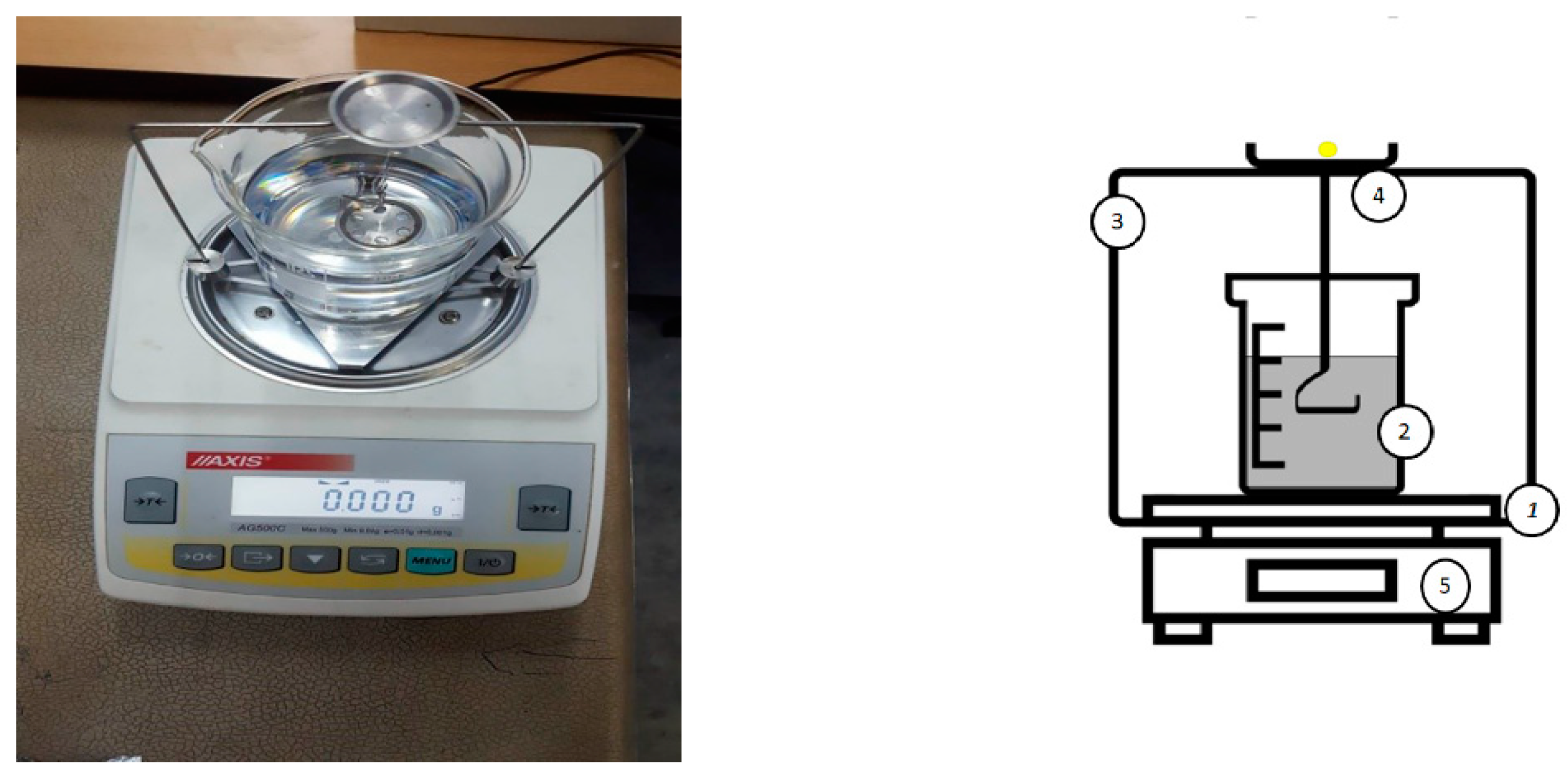
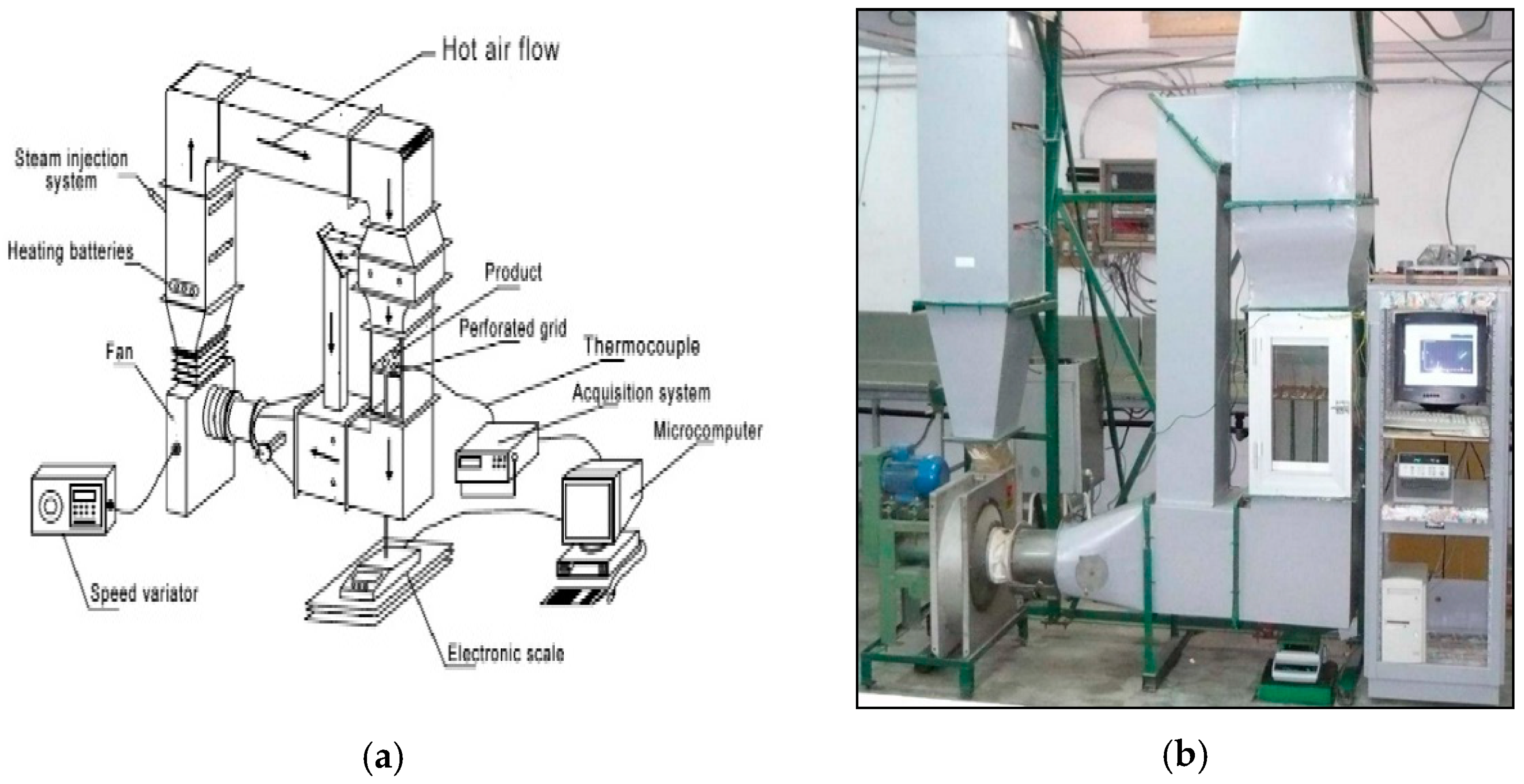
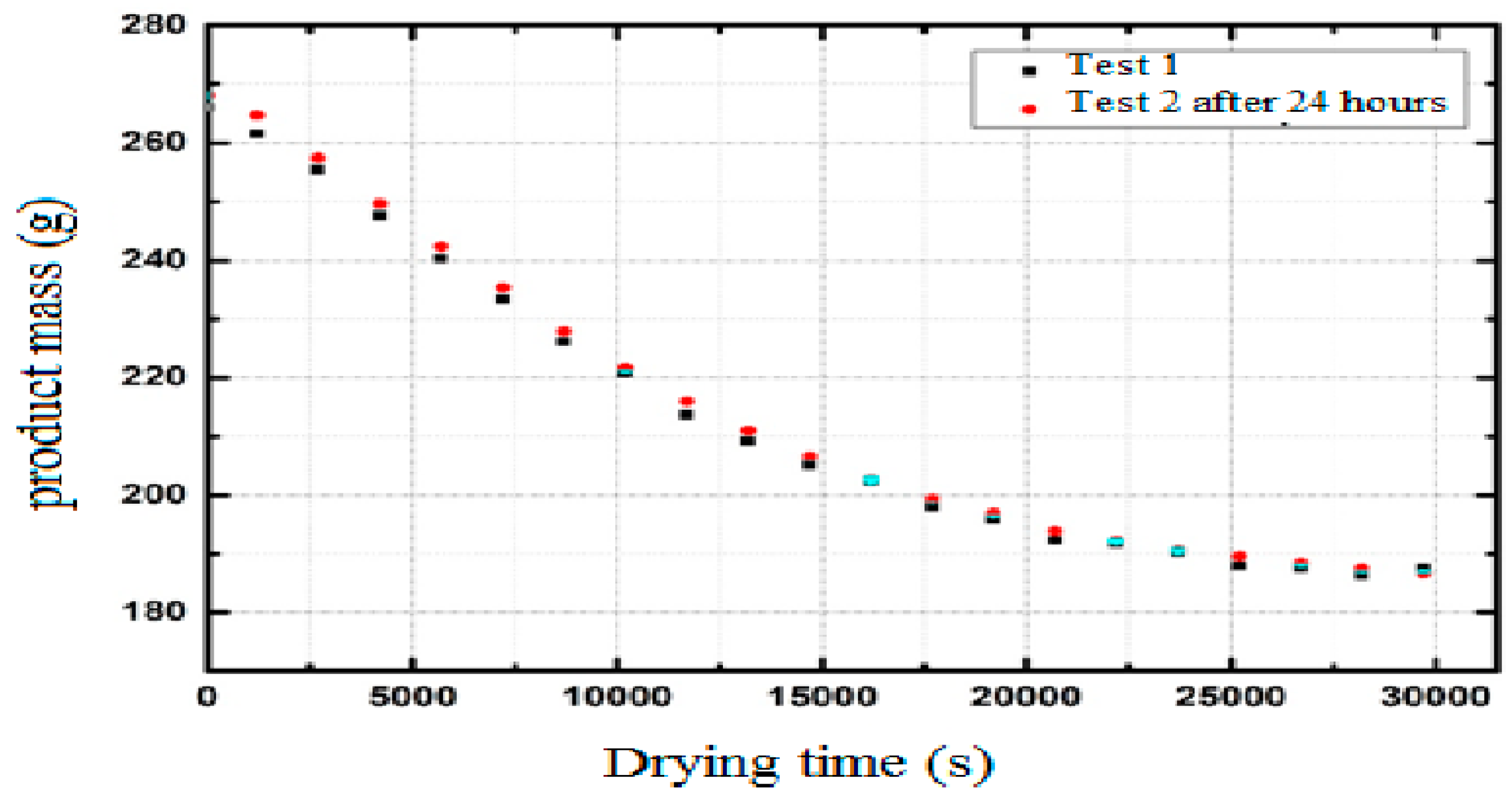
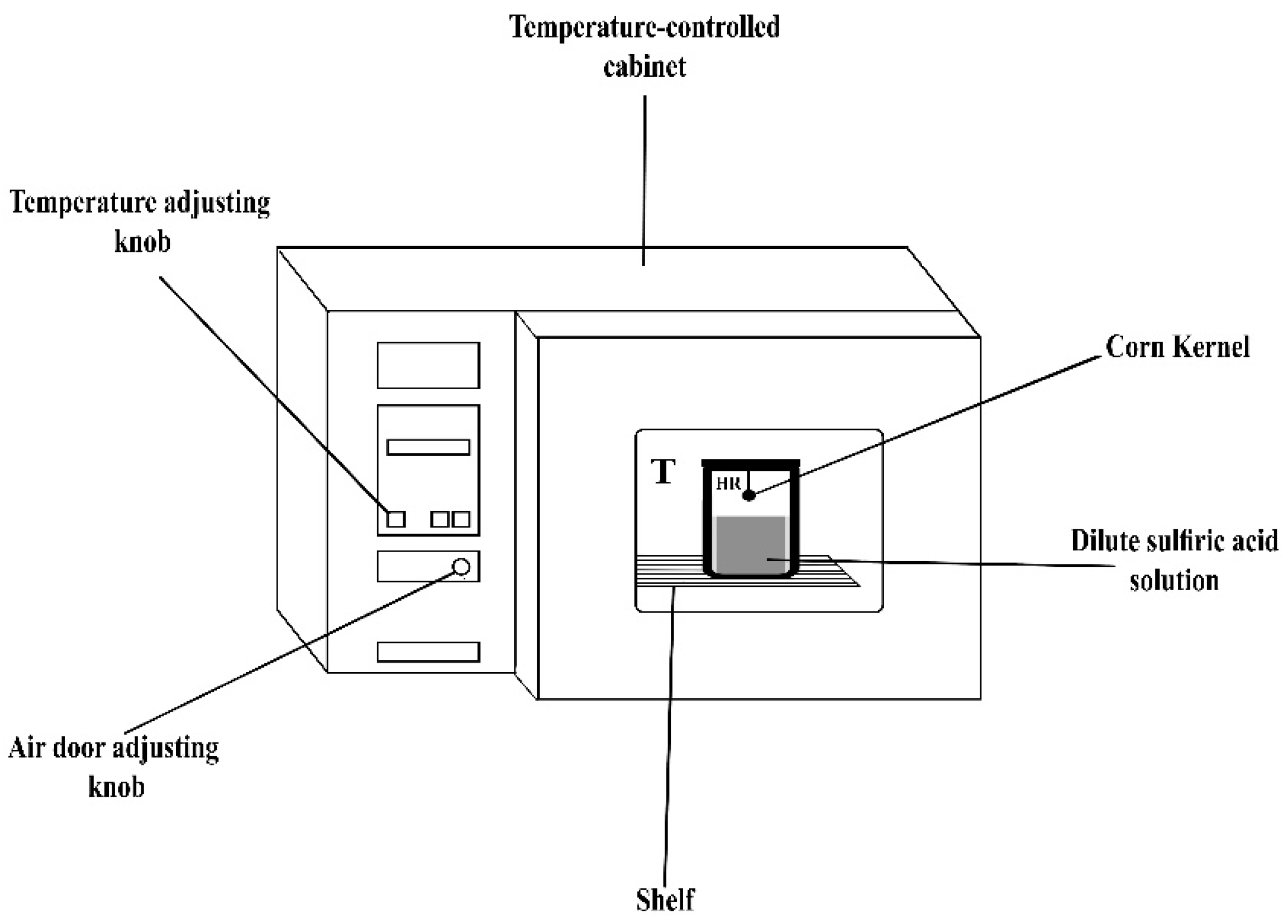
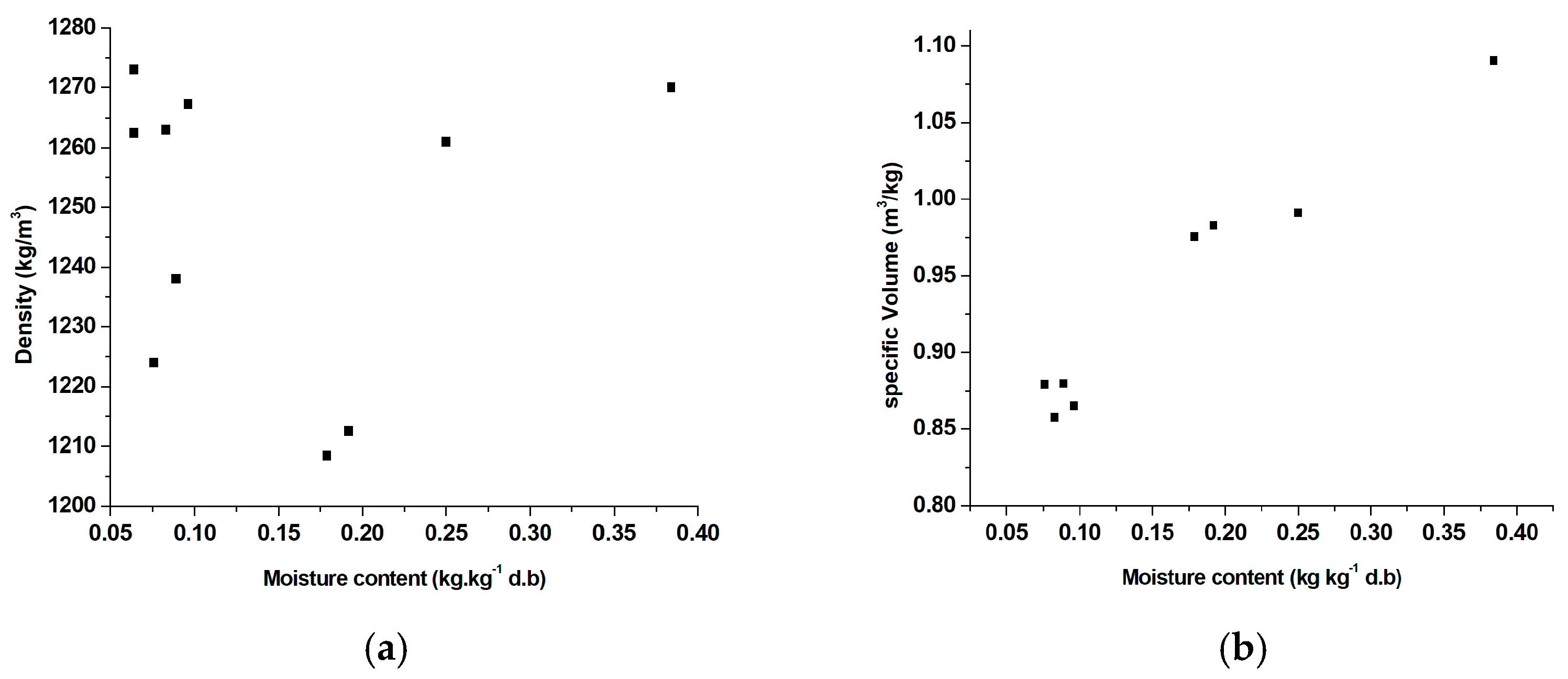
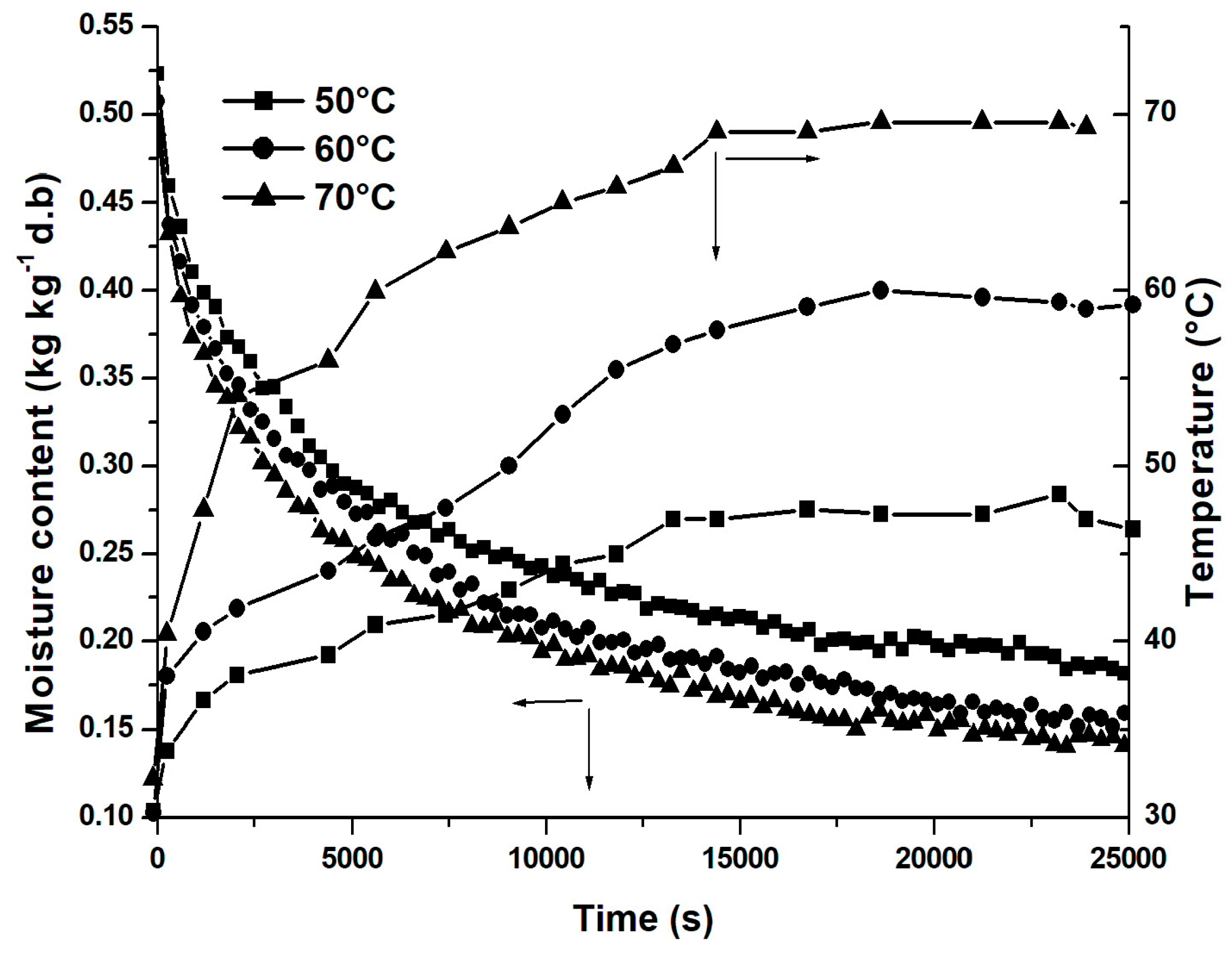
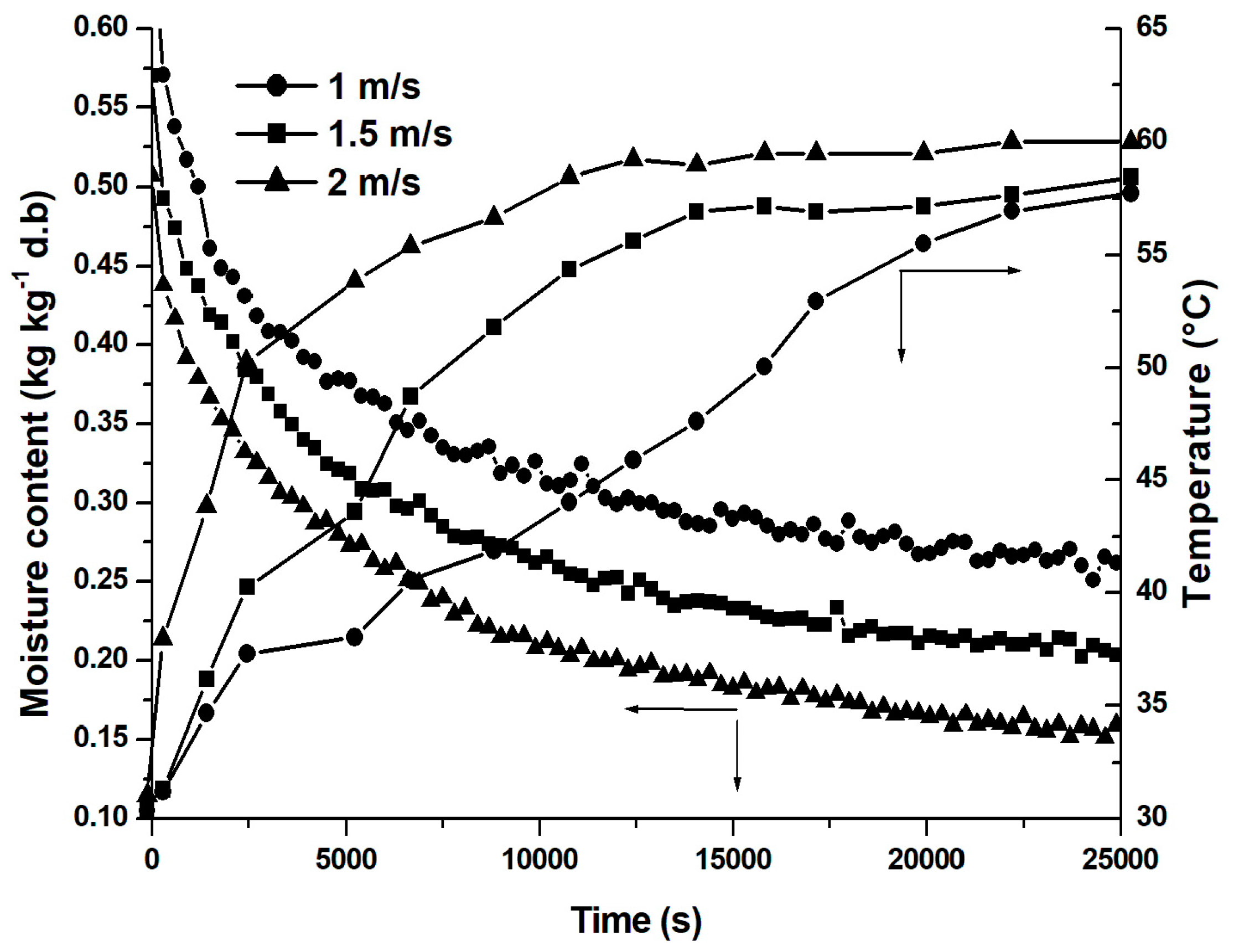
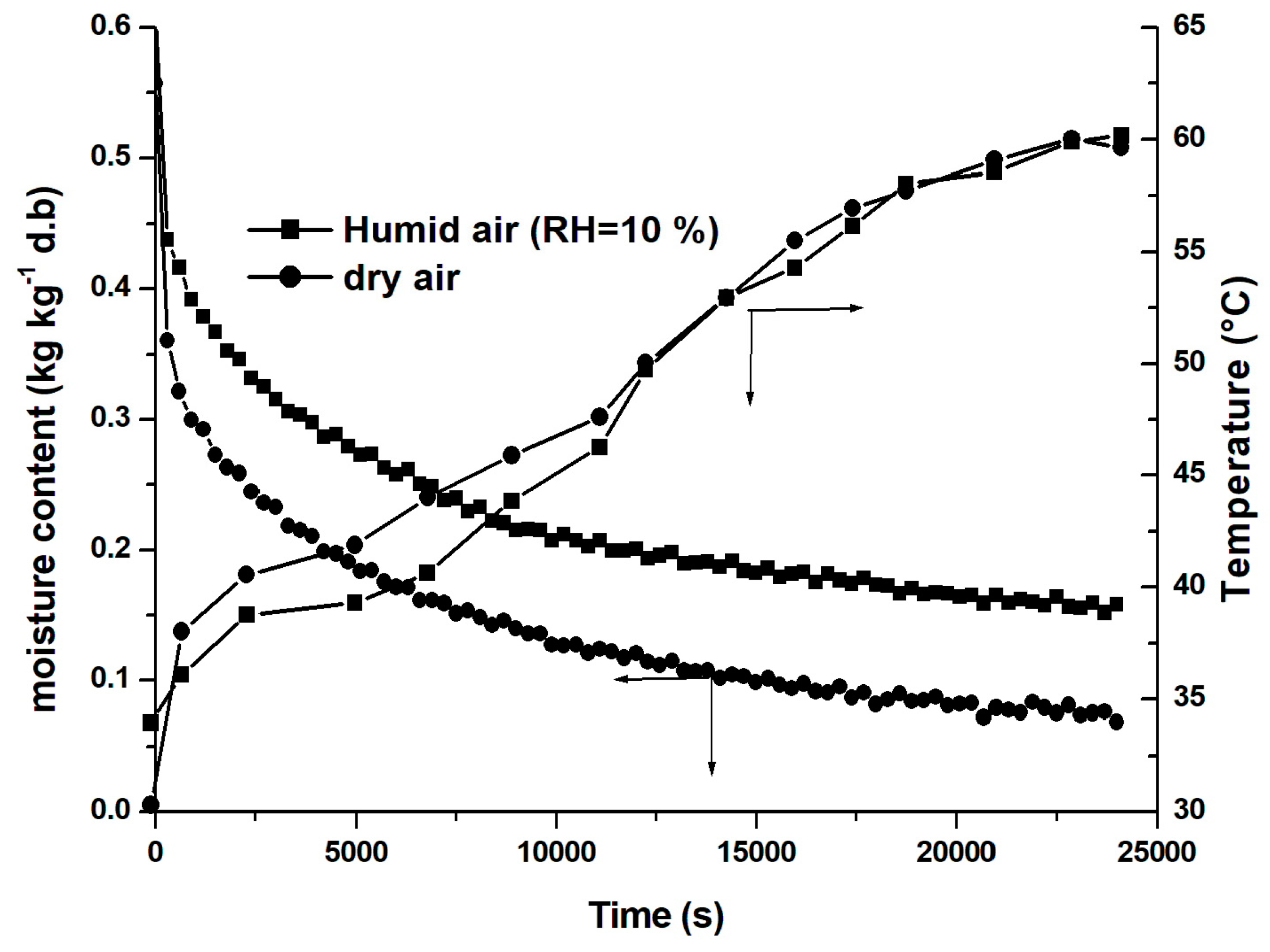

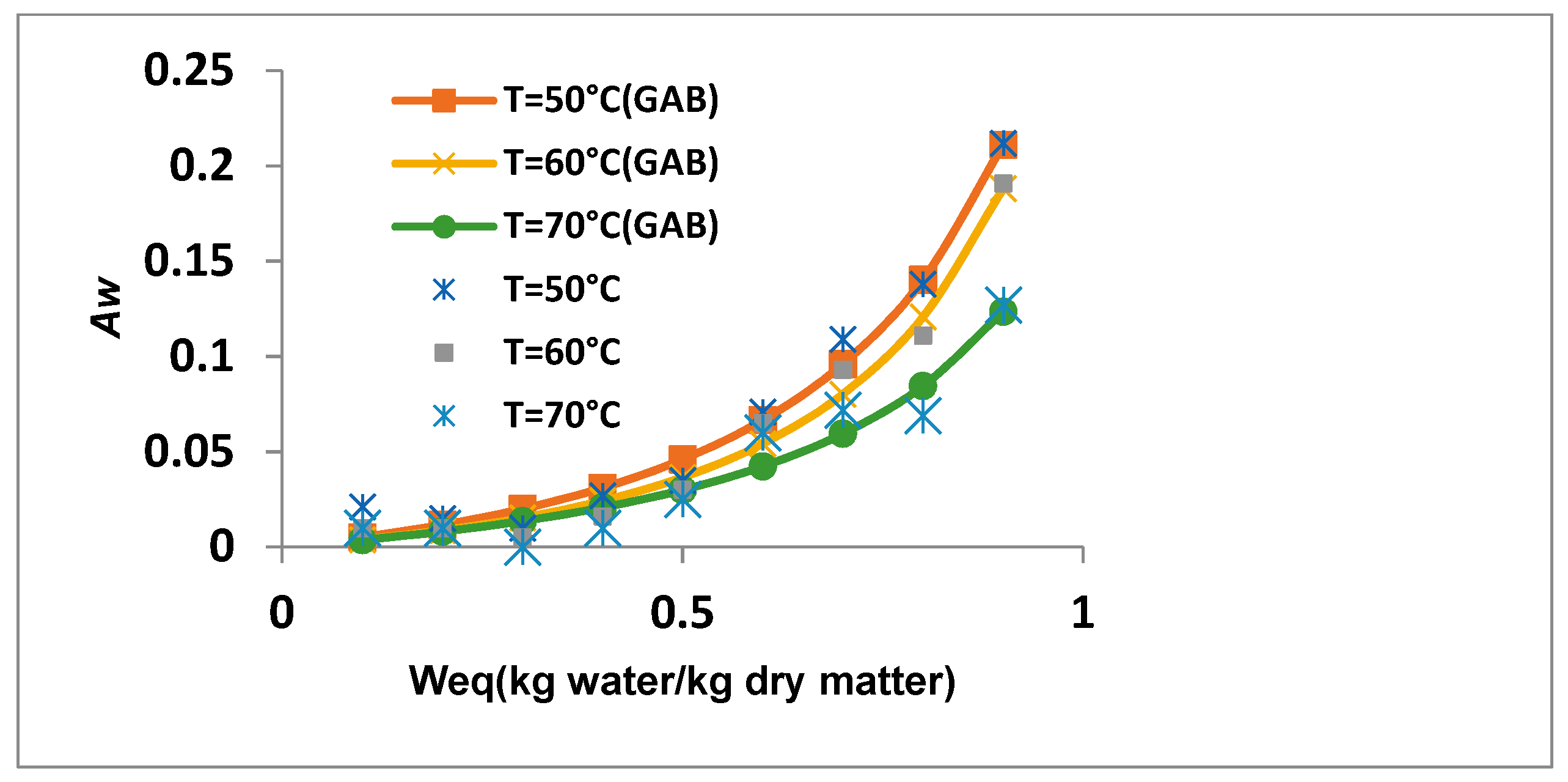
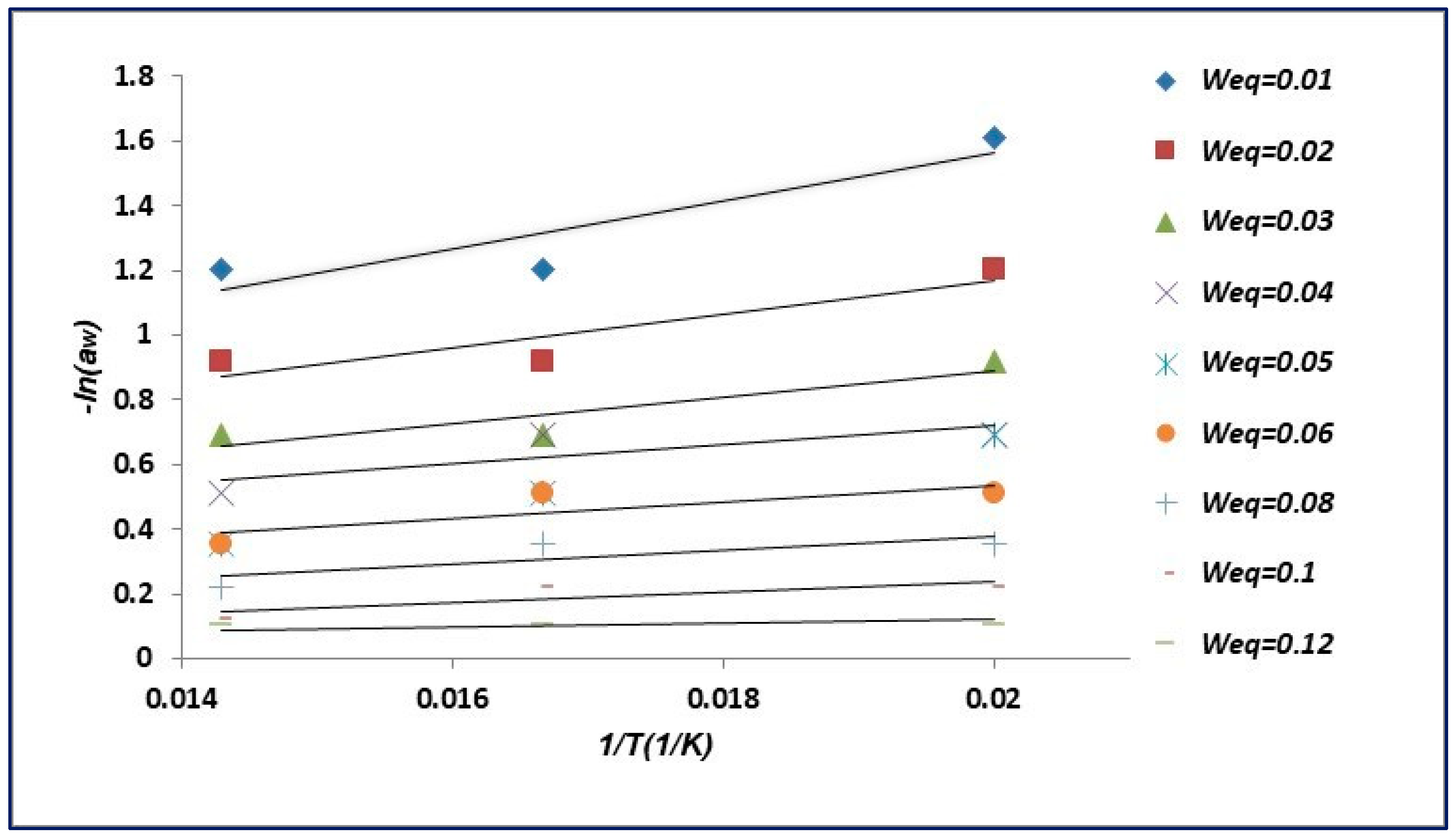
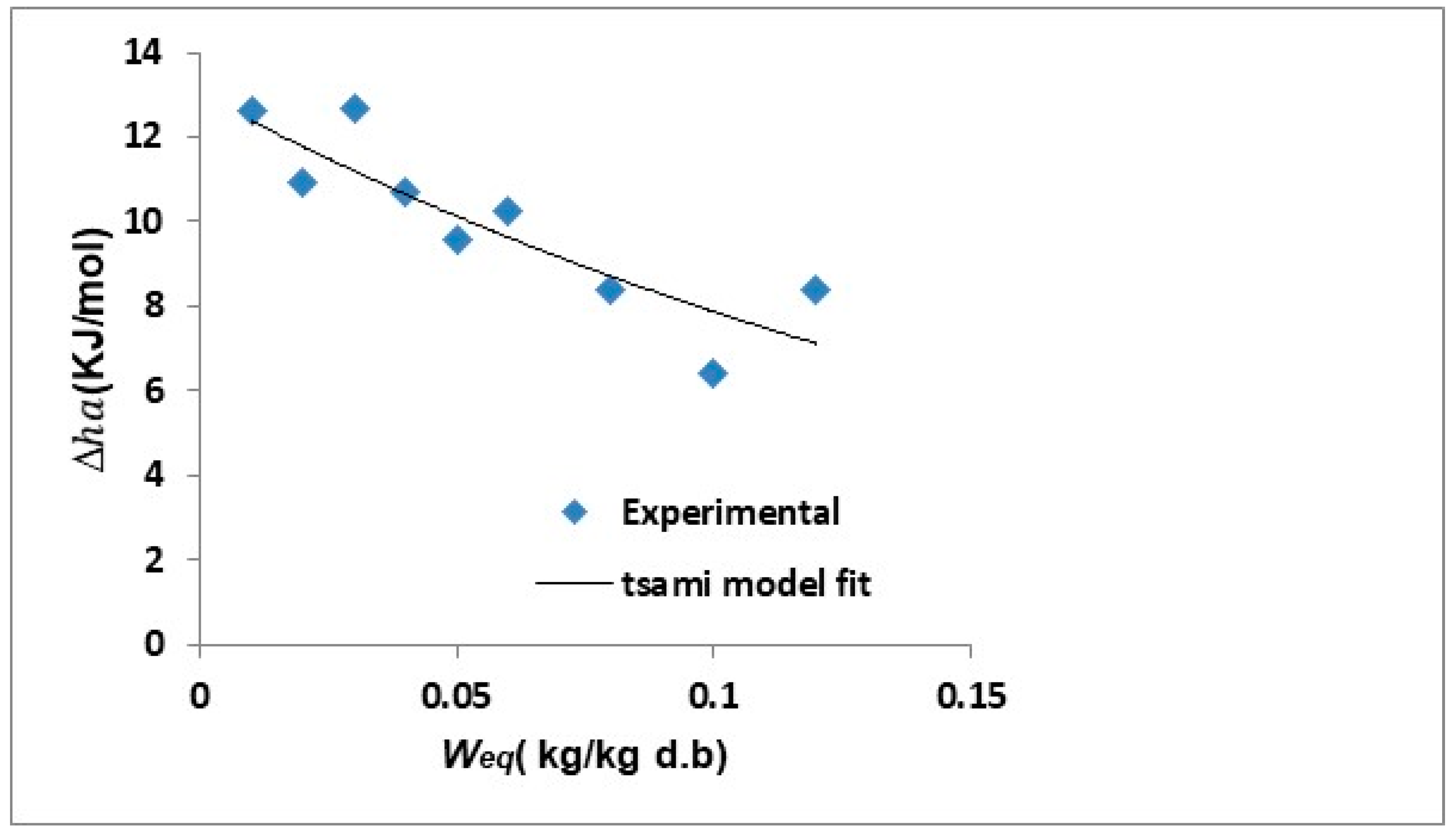
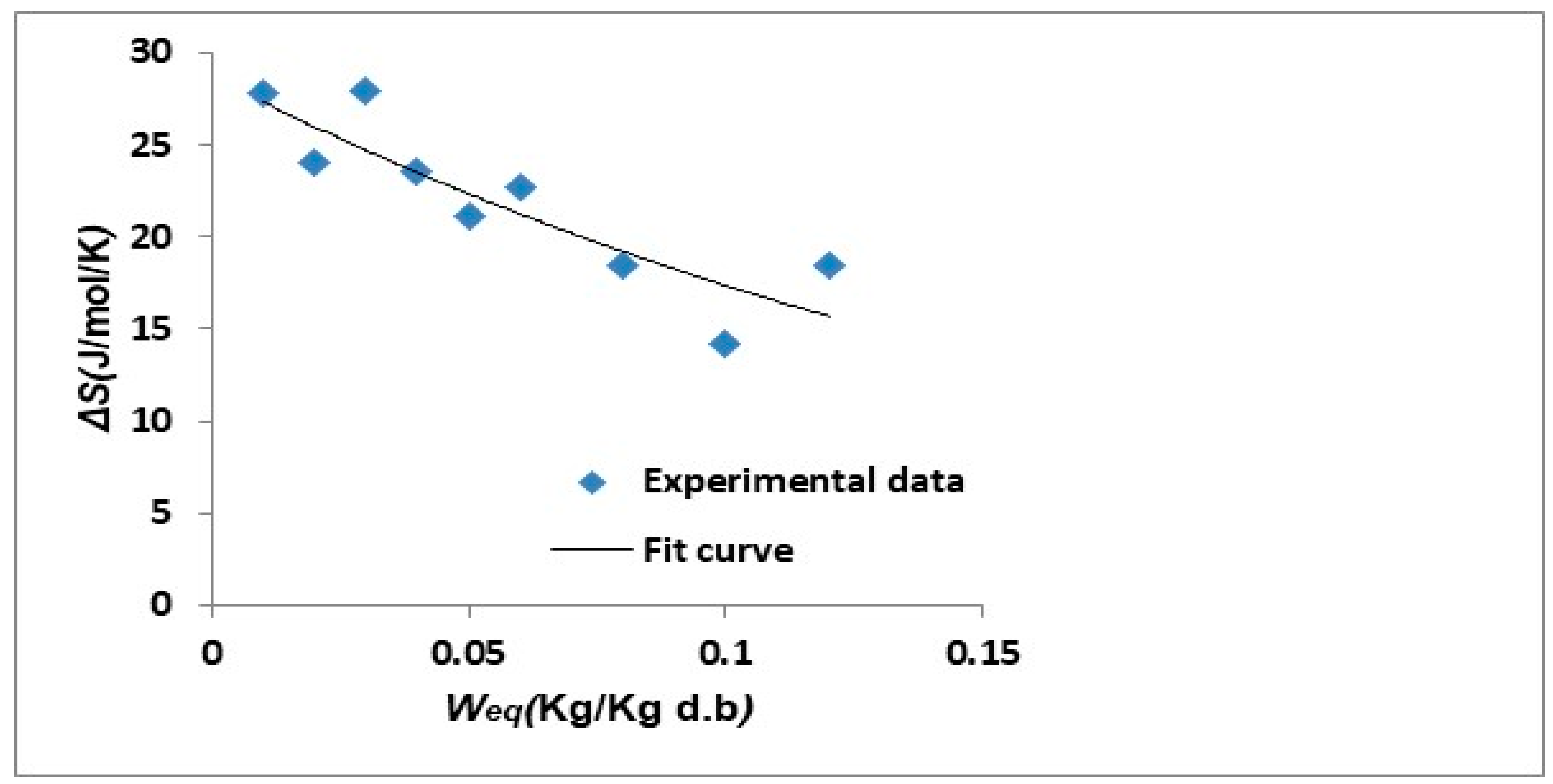
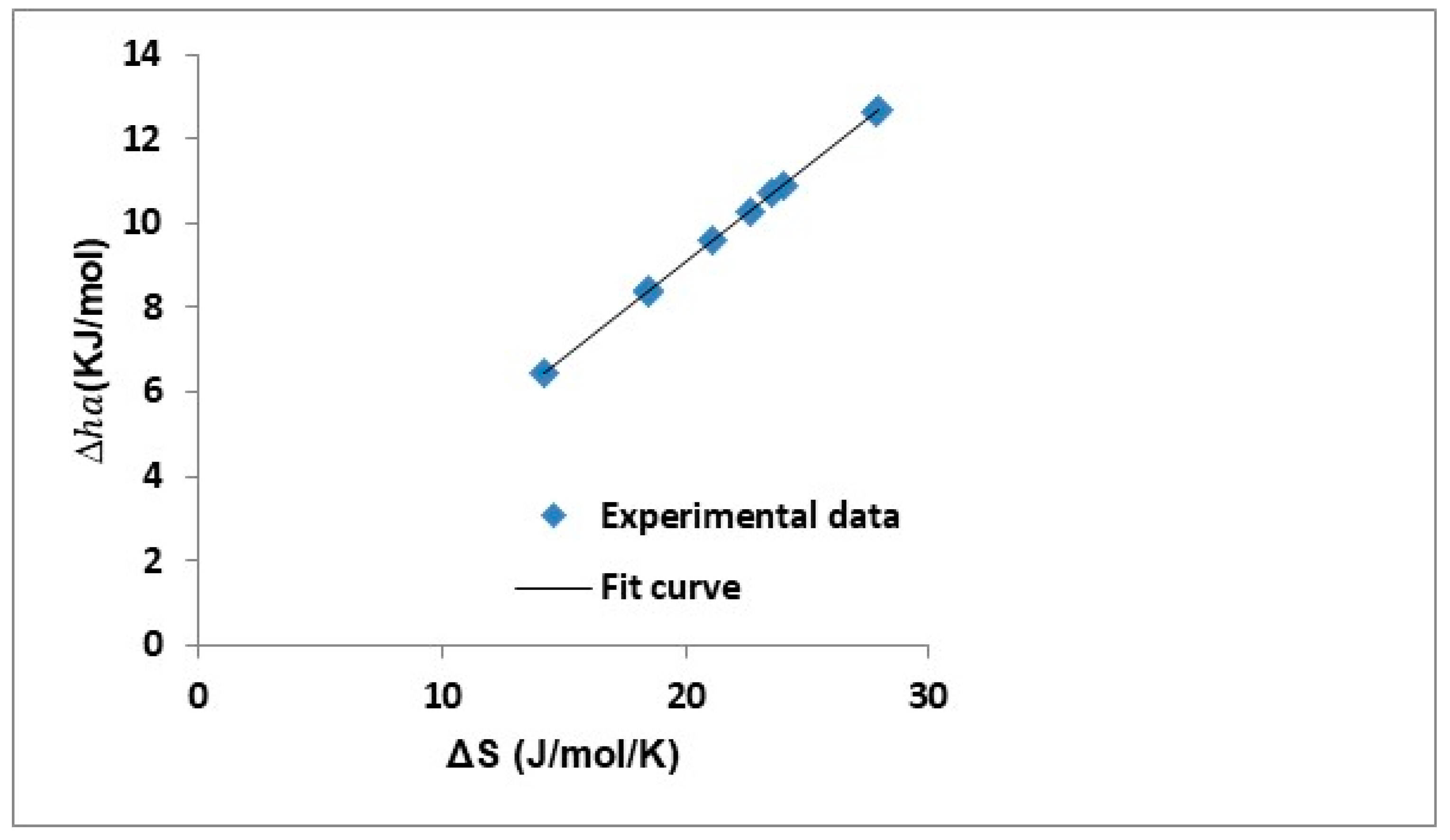
| Parameters | Range Values |
|---|---|
| V (m s−1) | 1–2 |
| T (°C) | 50–70 |
| H (mm) | 7–40 |
| RH (%) | 0–10 |
| Xi | 0.45–0.65 |
| Mi (g) | 32 |
| Ti (°C) | 30 |
| Instrument | Range | Estimated Uncertainty |
|---|---|---|
| Electronic scale ‘Mettler Toledo’ | 0.5–6000 g | ±0.01 g (based on manufacturer’s specification) |
| Hygrometer | Humidity: 0–100% RHTemperature: from −20 to +120 °C (polycarbonate probe) from −40 to +180 °C (st. steel probe) | ±1.5% RH (from 3 to 98% RH and if 15 °C ˂ T ˂ 25 °C) ±0.3% of reading ±0.25 °C |
| Thermocouples (type K) | Temp −270 to 1372 °C | 2.2% to 0.75% (based on manufacturer’s specification) |
| Anemometer | 0.30 to 15 m/s | ±0.05 m/s or ±1% |
| H2SO4 Solution % (v/v) | Water Activity (aw) | ||
|---|---|---|---|
| 50 °C | 60 °C | 70 °C | |
| 10 | 0.9268 | 0.9315 | 0.9382 |
| 20 | 0.8629 | 0.8652 | 0.8782 |
| 30 | 0.7396 | 0.7450 | 0.7531 |
| 40 | 0.5727 | 0.5810 | 0.5906 |
| 50 | 0.3724 | 0.3820 | 0.3929 |
| 60 | 0.1865 | 0.1953 | 0.2050 |
| 70 | 0.0558 | 0.0614 | 0.0675 |
| 80 | 0.0082 | 0.0098 | 0.0116 |
| 90 | 0.0064 | 0.0082 | 0.0103 |
| Model | Mathematical Equation | Parameters |
|---|---|---|
| Henderson [76] | A, B | |
| Chung and Pfost [77] | A, B | |
| BET [36] | Wm, c | |
| GAB [78] | Wm, cm, k | |
| Halsey [79] | A, B | |
| Oswin [80] | A, B | |
| Peleg [41] | A, B, C, D |
| Model | Parameters | 50 °C | 60 °C | 70 °C |
|---|---|---|---|---|
| Henderson | A B Χ R2 | 7.81588 0.79598 0.01068 0.98954 | 7.80923 0.73925 0.00946 0.99007 | 13.23623 0.84434 0.01238 0.96174 |
| Chung and Pfost | A B Χ R2 | 1521.53594 14.92854 0.02256 0.95247 | 1719.32891 16.38211 0.01998 0.95490 | 0.01377 24.80268 0.01549 0.93943 |
| BET | Wm C Χ R2 | 0.02348 12.13207 0.02018 0.96213 | 0.02954 5.25950 0.01646 0.96963 | 0.01399 11.23162 0.01686 0.92777 |
| GAB | Wm C K Χ R2 | 0.12577 0.46201 0.77350 0.01070 0.99100 | 0.14317 0.29733 0.77159 0.01029 0.98992 | 0.05939 0.69460 0.78024 0.01346 0.96118 |
| Halsey | A B Χ R2 | 0.01597 1.25518 0.01688 0.97366 | 0.01586 1.16985 0.01525 0.97397 | 0.00766 1.29008 0.01516 0.94202 |
| Oswin | A B Χ R2 | 0.05000 0.67496 0.01423 0.98136 | 0.03989 0.72519 0.01264 0.98218 | 0.03101 0.65103 0.01382 0.95210 |
| Peleg | A B C D Χ R2 | 0.28051 2.90319 0.00152 −1.13955 0.00738 0.99644 | 0.20225 2.45031 1.83905 37.79465 0.00894 0.99367 | 0.07696 2.33712 0.07696 2.52032 0.01440 0.96306 |
Disclaimer/Publisher’s Note: The statements, opinions and data contained in all publications are solely those of the individual author(s) and contributor(s) and not of MDPI and/or the editor(s). MDPI and/or the editor(s) disclaim responsibility for any injury to people or property resulting from any ideas, methods, instructions or products referred to in the content. |
© 2023 by the authors. Licensee MDPI, Basel, Switzerland. This article is an open access article distributed under the terms and conditions of the Creative Commons Attribution (CC BY) license (https://creativecommons.org/licenses/by/4.0/).
Share and Cite
Kraiem, A.; Madiouli, J.; Shigidi, I.; Sghaier, J. Experimental Analysis of Drying Conditions’ Effect on the Drying Kinetics and Moisture Desorption Isotherms at Several Temperatures on Food Materials: Corn Case Study. Processes 2023, 11, 184. https://doi.org/10.3390/pr11010184
Kraiem A, Madiouli J, Shigidi I, Sghaier J. Experimental Analysis of Drying Conditions’ Effect on the Drying Kinetics and Moisture Desorption Isotherms at Several Temperatures on Food Materials: Corn Case Study. Processes. 2023; 11(1):184. https://doi.org/10.3390/pr11010184
Chicago/Turabian StyleKraiem, Amal, Jamel Madiouli, Ihab Shigidi, and Jalila Sghaier. 2023. "Experimental Analysis of Drying Conditions’ Effect on the Drying Kinetics and Moisture Desorption Isotherms at Several Temperatures on Food Materials: Corn Case Study" Processes 11, no. 1: 184. https://doi.org/10.3390/pr11010184
APA StyleKraiem, A., Madiouli, J., Shigidi, I., & Sghaier, J. (2023). Experimental Analysis of Drying Conditions’ Effect on the Drying Kinetics and Moisture Desorption Isotherms at Several Temperatures on Food Materials: Corn Case Study. Processes, 11(1), 184. https://doi.org/10.3390/pr11010184






